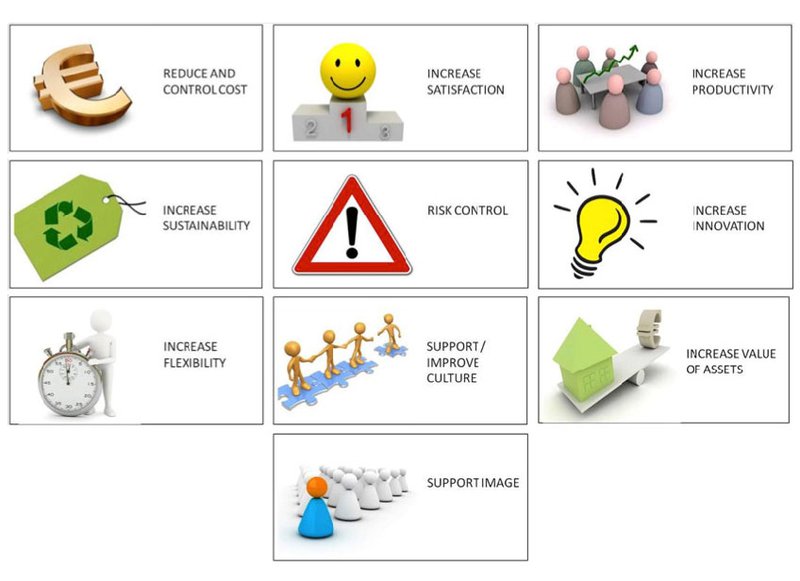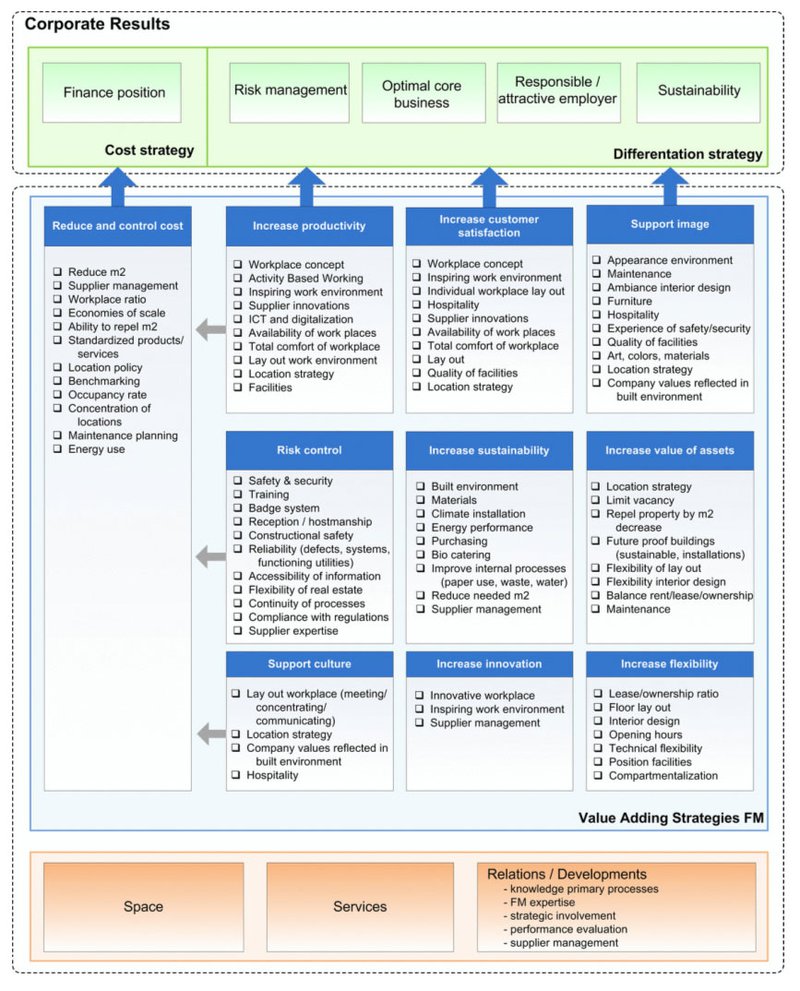
News
The Value of Facilities Management - a practical tool to measure the value of FM.

By Doranne Gerritse for “Facility Management Information”, periodical of Facility Management Netherlands, FMI No 6, 2013.
Translated by Jack Crutzen, chair of the education committee, FMANZ.
The added value which Facility Management can bring to an organisation is being increasingly recognised. But what exactly is that value? How do you make it visible and measurable? This article offers both an overview of how FM departments of six Dutch financial organisations manage added value, and a practical tool with which to clarify this.
Facility management is slowly detaching itself from the traditional view of being a cost saving department and instead being viewed as an essential business asset - for example, the importance of the working environment for staff productivity, or being an enabler for the image and culture of a company. There is also increased focus on defining the real added value proposition of FM for the organisation. Van der Voordt (see FMI 11, 2012) demonstrated this for hospitals. The Research Centre Hospitality of Saxion University of Applied Sciences responds to this development by means of a research programme that focuses on office organisations. The objective of the Research Centre is to translate the theory of added value into the practice of the facility manager. The result is a tool to show and measure the added value.
This article presents the first results of this research programme: a thesis research by Doranne Gerritse for the European Master Facility Management. Gerritse examined the ways in which added value of facility management is managed by six Dutch financial institutes (four banks and two insurance companies) in the largest segment (between 6,800 and 27,500 employees). Success factors were identified based on interviews and a round table discussion with FM experts. Based on these results, a conceptual model has been developed to clarify the (integrated) added value.
Not obvious
More and more FM becomes strategic in nature. Where, previously, the main objective was to create a functional and cost effective work environment, the current focus is changing towards creating a work environment that supports or improves the productivity as well as fully aligning with the ambitions, mission, core values and key objectives of the organisation. FM not only provides support for the organisation and its employees but also provides specific added value to the core business and becomes a more strategic partner in the organisation.
A more strategic position for FM is not always recognized or obvious. RICS (2012) researched the opinion of 400 FM professionals worldwide and highlights that often FM is not involved in the decision-making process in corporate business strategy. Consequently, the FM department experiences difficulties in delivering its optimal added value in time or at the right organisational level. Therefore, FM is often compelled to cut costs, without being able to clarify the (often negative) consequences for the core business of the organisation (e.g. loss of productivity or satisfaction).
This phenomenon was confirmed during the round table discussions, organised to enable FM professionals to exchange knowledge and experiences in regard to added value theories. During these meetings it became clear that FM is not always in time and at the right place involved in the design of optimal core business processes. According to the professionals, this is due to the fact that stakeholders do not know which (strategic) added value FM can contribute. FM does not always have the resources to clarify itself either. Measuring and benchmarking the usual three performance criteria of FM (costs, customer satisfaction and quality) is not always sufficient to demonstrate the total added value of FM.
Visible added value
Research by Van der Voordt (2012), Lindholm (2008), Jensen (2010) and Vader (2011) highlights that FM can have added value for the business in (at least) 10 different areas (see images 1 and 2). For example, by contributing to the flexibility of the organisation, by supporting the culture or promoting/stimulating innovation, FM has a positive influence on the results of the core business. This creates (and demands) a wider definition of the added value of FM, also defined as total business value.
Visualizing and demonstrating this total business value or added value of FM appeared to be difficult. Several values can be expressed easily (such as cost reduction or customer satisfaction). Other, less obvious values are more difficult to express (such as the contribution to brand support or the contribution to productivity). These forms of value addition contribute indirectly to the results of the business and are, therefore, often difficult to express in Key Performance Indicators (KPIs). In addition, these values are often not part of the accountability process of FM. The thesis research at the financial institutes highlighted that criteria highly valued by facility managers had no influence on the accountability to senior/executive management. The facility managers ranked cost control and reduction as well as increased productivity as the number 1 and 2 key contributions of FM for the core business (key added values). Increased customer satisfaction and brand support were mentioned as the third and the fourth most important contributions, followed by risk management, sustainability and increased innovation. From the analysis of accountability processes it appeared that the assessment of FM added value is mainly based on costs, risk management and customer satisfaction (besides the usual service level agreement accountability) and thus not explicitly on other added value criteria (like contribution to image or cultural change). This does not indicate that the other criteria have no influence on the FM delivery. It highlights that not all added value areas of FM are considered in the decision making process.
The thesis research therefore focused on how the FM organisation could clarify and judge its total added value. By means of interviews with facility managers, a list of critical success factors (CSFs) per added value area were identified. Furthermore, an analysis has been made of the corporate business objectives of the six financial institutions and the contribution of FM to these objectives, based on Nourse & Roulac (1993).

Image 1: FM added value impact areas on core business, based on Lindholm (2008), Van der Voordt (2012), Jensen (2010), Vader (2011).
Real estate strategy
Nourse & Roulac developed eight real estate strategies to align real estate activities with the key driving forces of the corporate business strategy. For example: a business strategy focussed on technology (like Google) mostly benefits by a real estate strategy that is based on flexibility and support of culture. The management of the ideal mix of strategies by the Head of Real Estate contributes to the optimal added value delivery to the business.
Based on the example of Nourse & Roulac, several CSFs from this thesis research have been developed into added value strategies for FM applicable to the involved institutes. The layout of the work environment was labelled as an essential success factor for cultural change or support. Initiatives such as maintenance of buildings or hospitality were labelled as success factors that support or contribute to the image or brand. Subsequently, the relationship between FM criteria and the objectives of the corporate organisation has been mapped. A differentiation has been made between financial and non-financial objectives. Non-financial objectives indirectly influence the achievements of the business and promote the distinctive character of the business (such as sustainability). Image 2 shows the results in one model. The structure of the model is based on the FM Value Map by Jensen (2010) in which FM, through management of space and services (but also through the development of relations and expertise), adds specific value to the core business of the organisation.
Practical Management Instrument
The model highlights which success factors the facility manager can control or manage to optimise the added value. The added value strategies show which buttons to “rotate” and which opportunities to explore. The model highlights, in one glance, the contribution that FM delivers to the corporate business objectives. For example: the success factor inspiring work environment adds value through increased customer satisfaction and productivity, but also supports the “battle for talent”. A FM department that is able to create a work environment that is appealing for the target group contributes not only to the core business (satisfied and productive employees), but also to the image of being an attractive and responsible employer. Based on the analysis of annual reports these were found to be part of the strategic objectives of the organisations. Also other success factors, in the sphere of influence of the facility managers, had strategic importance to the business, such as sustainability, risk management or flexibility (as optimal core business support): areas in which FM adds essential value.
The model is a first attempt to provide a practical tool or instrument for managing the added value of FM. It helps the facility manager to demonstrate, highlight and optimise its total added value. Together with senior/executive management and other stakeholders the facility manager can use the tool to define which combination of FM strategies contributes the best to the success of the organisation. For example, if the business is subject to rapid changes in the market, the focus could lie on a flexibility strategy by FM. By doing so, the model not only provides a better insight in the added value of FM to the core business, it also becomes an instrument for strategic planning.
The model requires further development and refinement to be able to apply in a wider scope. Further research questions are for example: which CSFs are relevant in each added value strategy and in which business sector (e.g. health care versus office organisations)? And, how can these CSFs be translated into measurable indicators? It would also be valuable to investigate the relationship between the core business objectives and the FM criteria on a wider scale. The Research Centre Hospitality of Saxion will focus on these queries in their research programme and is keen to cooperate with businesses.

Image 2: Conceptual model for demonstrating added value of FM in relation to core business and corporate performance. Based on Jensen (2010), Lindholm (2008), Vader (2011) en Van der Voordt (2012)
If interested in further information or discussion please contact Doranne Gerritse (d.gerritse@saxion.nl) or Feike Bergsma f.h.j.bergsma@saxion.nl). Doranne Gerritse finished her master degree on FM added value management and is currently working as researcher/FM specialist at the Research Centre Hospitality at Saxion. See http://www.saxion.nl/hospitality